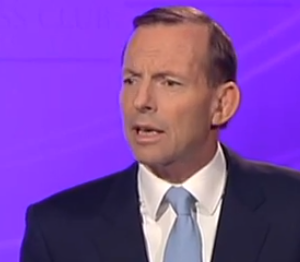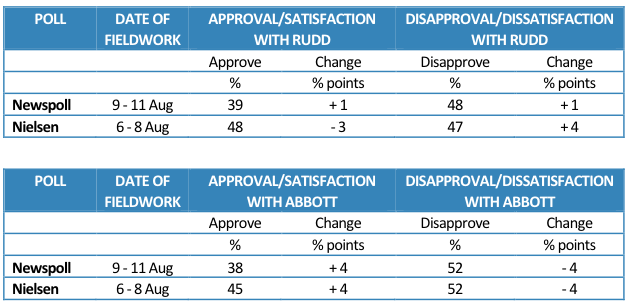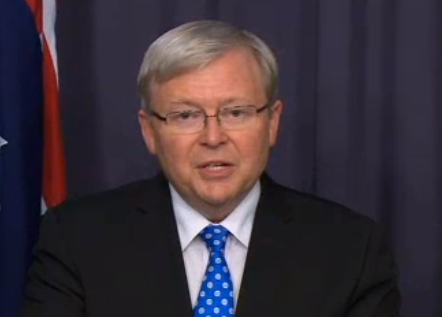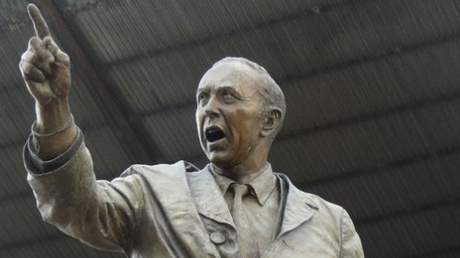WHILE THE movements in election opinion polls over the past week have been small – within their margins of error – they are all pointing in the same direction: support for Labor has plateaued and is probably subsiding slightly.
The two-party-preferred results are summarised here:

* The Morgan two-party-preferred shown here is the one calculated using the same procedure as the other polls, based on how voters allocated their preferences at the last election. Using Morgan’s own method, based in how respondents to the survey said they would vote, the two-party-preferred comes out 50-50.
Looking back over the past two months, the pattern of poll results is also clear. Labor got its bounce from the installation of Kevin Rudd as leader. That bounce was of the order of six or seven percentage points, and brought down the two-party-preferred margin between the two main parties to two points or less.

Nielsens had them level-pegging in its first poll after the leadership change, and Newspoll had the gap at two points – 51% to the Coalition and 49% for Labor.
Since then, however, there seems to have been a small drift away from Labor. The sampling error for most of these polls is about plus or minus 3 percentage points, so it could be argued that a drift or one or two points represents no real change. However, the consistency across all the polls suggests at a commonsense level that the movement probably is real.
If this pattern holds on election day, the Coalition would win, but depending on how the vote fell in individual electorates, Labor would probably succeed in “saving the furniture”.
Data on voter approval or satisfaction with the two main party leaders, and who is preferred as Prime Minister, reinforce this apparent trend.
As the tables below show, Mr Rudd’s satisfaction rating as measured by Newspoll is up a point, but so is his dissatisfaction rating, while Nielsen shows his approval rating falling and his disapproval rating rising. For Mr Abbott the picture is unambiguous: his approval/satisfaction ratings are up and his disapproval ratings are down.

Even so, Mr Rudd remains preferred Prime Minister, although his margin over Mr Abbott is narrowing.

The leaders’ televised debate last Sunday produced inconclusive results, based on a mixture of online, SMS and continuous voter-response methods. Morgan’s SMS poll showed 24% gave it to Mr Rudd, 23% to Mr Abbott, 5% rated it a draw and – most tellingly of all – 48% didn’t watch it.
An online survey by The Age gave it to Mr Abbott 48-44, with 8% undecided. Responses to the various television audience surveys were all over the place:

Two commercial stations audiences gave it to Rudd and one to Abbott. The ABC and Channel Seven audiences were not only extraordinarily different from one another, but also very different from the Nine and Ten audiences, who showed considerable unanimity. It is hard even to speculate about what this might mean. While it is tempting to say that the ABC audience is probably more pro-Labor than the commercial audiences, is it plausible that Channel Seven’s audience is so much more pro-Coalition than either Channel Nine’s or Ten’s? The safe course is not to attach too much importance to any of them.

Speaking of unreliability, there was a cautionary tale in The Australian yesterday about data from social media. According to this report, the Liberal Party has acted to “stop the bots”, as the two reporters, Rick Morton and Harry Edwards, entertainingly put it. They reported that a PhD student had revealed a “dramatic spike” in Tony Abbott’s personal Facebook and Twitter followings – hundreds of thousands over the past fortnight. The student’s analysis had shown that his popularity was growing faster than that of One Direction, Justin Bieber and Facebook itself.
The Liberal Party was reported as having repudiated such fakery and as having taken action to remove the bogus accounts.
It is a timely reminder of the worthlessness of much uncontrolled junk masquerading as survey data, including the phone-ins or online equivalents so beloved of media outlets: Should Kevin Rudd dye his hair green? Dial this for yes and that for no.




